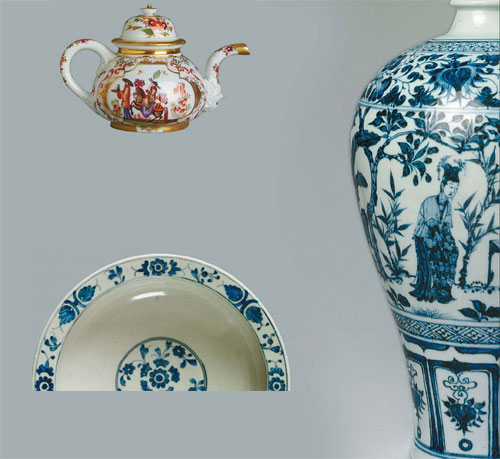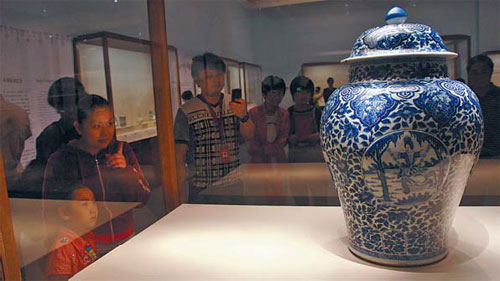Lofty Lushan Mountain
Temples in Hidden Places
On the First of August
Wheels by the Water
Share your travel story with regional@chinadaily.com.cn
Porcelain homecoming
By Zhu Linyong ( China Daily )
Updated: 2012-06-29
 |
|
Highlights among the 146 ancient ceramic works exhibited at the National Museum of China include a Meissen teapot (top left), a Ming Dynasty (1368-1644) blue-and-white vase (right) and a Medici porcelain dish (bottom left). Photos provided to China Daily |
 |
|
Passion for Porcelain is the National Museum of China's latest offering. Jiang Dong / China Daily |
Some ceramic pieces made during the Ming Dynasty bear European designs. Zhu Linyong finds out more about the origins of such porcelain wares at an exhibition in the National Museum of China.
Hundreds of years ago, innumerous porcelain wares traveled afar to the Middle East and European countries where they became treasured pieces in both private and national treasure troves. Now, they are making a homecoming visit. The British Museum and the Victoria and Albert Museum of the United Kingdom have brought to the National Museum of China 146 selected masterpieces of ancient Chinese ceramic art for a grand exhibition titled Passion for Porcelain. The exhibition also celebrates the London Olympic Games and the 40th anniversary of the diplomatic ties between China and the UK, says National Museum of China Director Lu Zhangshen.
It comprises masterpieces that tell a fascinating story about trade and cultural links between China and Europe - and especially the UK - from the 16th to 19th centuries.
For example, on display are some Ming Dynasty (1368-1644) export ceramics that show European and Latin influences, such as a bowl with European armorial designs and Latin inscriptions.
Using photos, charts, posters and illustrations, the exhibition also looks at the shipping, ports and business arrangements developed by East India companies in the 17th and 18th centuries.
"Porcelain is truly the world's first global commodity," says British Museum Director Neil MacGregor.
He believes porcelain is an effective way for people from different cultural backgrounds to communicate.
"It was through this exotic product that many British households began to have an idea of Chinese culture," he says.
Running until Jan 6 next year, the 10-section, comprehensive show traces how Chinese ceramics were manufactured in production bases, such as Jingdezhen in Jiangxi province, and shipped to Europe, and how they influenced the early development of European porcelain industries.
The show vividly illustrates how designs, technologies and ideas flowed between the two continents and reflects the history of Chinese ceramic art collection in the UK.
All exhibits bear detailed captions in English and Chinese. The organizers have also printed a catalogue, written by curators from the three museums, in both English and Chinese.
A larger section is devoted to what experts call special orders - Chinese porcelain specially commissioned by European purchasers and printed with European designs, such as a punchbowl with a scene borrowed from a lithograph by William Hogarth.
Some exhibits also offer clues on how Chinese porcelain influenced the early growth of European porcelain factories, and the exchange of design ideas and manufacturing technologies.
Exhibits that show early European attempts to make their own porcelain include a rare dish, created in what was later called Medici porcelain.
The copying trend is further illustrated through the display of European ceramics borrowing Chinese designs, such as a Worcester dish with a traditional Chinese pattern and Chinese porcelain copying European prototypes.
Other highlights include a Meissen teapot, presenting the phenomenon of European Chinoiserie, and blue-and-white ceramic products.
The final section of the exhibition explores the collection of Chinese porcelain in the UK, including outstanding pieces from the Song (960-1279) to the Qing (1644-1911) dynasties, such as a rare Ru kiln bottle and a blue-and-white vase.
MacGregor says there has been a growing desire among the British public to know more about Chinese arts and culture in recent years.
The British Museum collects a wide range of art and culture items that span China's long history.
The collection includes about 5,000 paintings, prints and drawings, about 1,000 jades, more than 4,000 bronze and metal objects, some 8,000 ceramics and about 500 art pieces made of materials, such as lacquer, cloisonne, glass and textiles. It also has a major collection of Chinese coins and money.
The museum holds significant long-term loans, including jades in the Alleyne Gallery and the Sir Percival David Collection of nearly 1,700 Chinese ceramics.
Of the roughly 25,000 Chinese items, including ceramic shards, nearly 4,000 non-light sensitive objects are on permanent display across the museum. And the museum continues to acquire objects for its Chinese collections, particularly contemporary art pieces.
More importantly, the British Museum "has a long-standing and ongoing program of activities in and with China", MacGregor says.
For instance, the First Emperor: China's Terracotta Army, held from September 2007 to April 2008, was probably the museum's most successful exhibition to date, attracting more than 850,000 visitors.
Among the museum's programs for late this year are displays of works by contemporary Chinese artists Zhan Wang, Xu Bing and Sui Jianguo, and an exhibition of contemporary Chinese seals by former vice-premier Li Lanqing.
Meanwhile, the Victoria and Albert Museum has also played an active role in presenting intercultural exhibitions and programs between China and the UK, the museum's deputy director Beth Mckillop says.
This autumn, Water into Art: Highlights from the V & A Collection will open at Shenzhen Museum. Another exhibition, The Splendor of India's Royal Courts, will be launched early next year at the Palace Museum in Beijing.
Passion for Porcelain is the second major international exhibition the National Museum of China has staged since its opening in April 2011.
The newly renovated and expanded museum is the world's largest public museum, with a floor space of nearly 200,000 square meters and more than 1.2 million cultural relics and artworks in its collections.
The museum staged its first international exhibition, Art of Enlightenment, in collaboration with the Berlin State Museums, Dresden State Art Collections and the Bavarian State Painting Collections from April 2, 2011, to March 31 this year, attracting about 500,000 visitors.
Lu believes the ceramic show will also be a magnet for visitors.
To attract more Chinese viewers, the three museums have been working with China Central Television over the past five months to shoot a documentary about the history of Chinese ceramic art in Europe, based on the contents of the exhibition.
The shooting will wrap up within weeks and the show will be broadcast on the TV station's documentary channel, producer Zhou Yan says.
9 am-5 pm, until Jan 6, 2013, (closed on Mondays and public holidays). National Museum of China, 16 East Chang'an Avenue, Dongcheng district, Beijing. 010-6511-6400.
Contact the writer at zhulinyong@chinadaily.com.cn.




